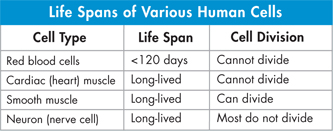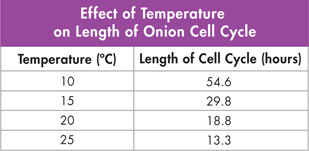10.4 Cell Differentiation
Understand Key Concepts
Bone marrow cells that produce blood cells are best categorized as
embryonic stem cells.
adult stem cells.
pluripotent.
totipotent cells.
Which type of cell has the potential to develop into any type of cell?
totipotent
pluripotent
multipotent
differentiated
What is a blastocyst?
What is cell differentiation and how is it important to an organism's development?
Describe two ways that technology may address the ethical concerns related to stem cell research.
Think Critically
Relate Cause and Effect When researchers discovered how to make skin stem cells pluripotent, how did they apply their discovery to the treatment for heart attack patients?
Compare and Contrast How does embryonic development and cell differentiation in C. elegans differ from how these processes work in mammals?
Connecting Concepts
Use Science Graphics
Use the data table to answer questions 34 and 35.
Compare and Contrast Based on the data, in what ways might injuries to the heart and spinal cord be similar? How might they differ from injuries to smooth muscles?
Predict If cancer cells were added to the table, predict what would be written in the Life Span and Cell Division columns. Explain.
Write About Science
Explanation Recall what you learned about the characteristics of life in Chapter 1. Explain how cell division is related to two or more of those characteristics.
Assess the
 How is cancer an example of how changes to a single cell can affect the health of an entire organism?
How is cancer an example of how changes to a single cell can affect the health of an entire organism?
Analyzing Data
A scientist performed an experiment to determine the effect of temperature on the length of the cell cycle in onion cells. His data are summarized in the table below.
Interpret Tables On the basis of the data in the table, how long would you expect the cell cycle to be at 5°C?
less than 13.3 hours
more than 54.6 hours
between 29.8 and 54.6 hours
about 20 hours
Draw Conclusions Given this set of data, what is one valid conclusion the scientist could state?
Table of Contents
- Formulas and Equations
- Applying Formulas and Equations
- Mean, Median, and Mode
- Estimation
- Using Measurements in Calculations
- Effects of Measurement Errors
- Accuracy
- Precision
- Comparing Accuracy and Precision
- Significant Figures
- Calculating With Significant Figures
- Scientific Notation
- Calculating With Scientific Notation
- Dimensional Analysis
- Applying Dimensional Analysis






